Joaquin Phoenix Joker
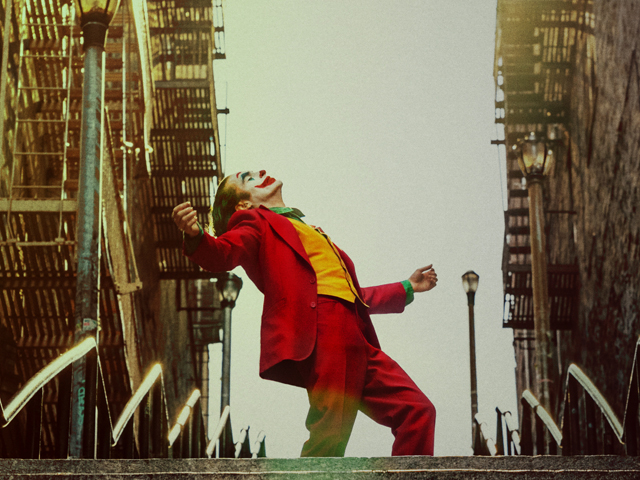
"My mother always tells me to smile and put on a happy face..." "Arthur Fleck
Cast: Joaquin Phoenix, Robert De Niro, Bill Camp, Zazie Beetz, Douglas Hodge, Shea Whigham, Frances Conroy, Josh Pais, Marc Maron
Director: Todd Phillips
Genre: Crime, Drama
Rated: MA
Running Time: 122 minutes
Synopsis: Warner Bros. Pictures' "Joker" stars Oscar nominee Joaquin Phoenix in the title role, alongside Oscar winner Robert De Niro, and is directed, produced and co-written by Oscar nominee Todd Phillips. "Joker" centers around the iconic arch nemesis and is an original, standalone story not seen before on the big screen. Phillips' exploration of Arthur Fleck, a man disregarded by society, is not only a gritty character study, but also a broader cautionary tale.
Joker
Release Date: October 3rd, 2019
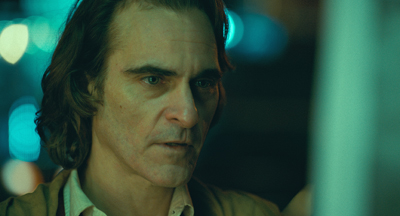 About The Production
About The Production
It's the early 1980s, and Gotham City is in turmoil. But there is no criminal underbelly at work, nor a mob overlord putting all at risk to serve his own interests. It's a much more palpable concern for anyone living within the dystopian borders of this divided community of haves and havenots growing ever further apart, the tensions only exacerbated by a weeks-long garbage strike. Gotham is teetering on the edge of a fall; there is only the city and those who oversee it, and as in any municipality short of funding for the fundless, services designed to alleviate the difficulties of the disenfranchised are being cut.
No, this is not the Gotham, nor the Joker, one would recognize from 80 years of established storytelling depicted on the page or screen. Rather, this is an original, standalone origin of this infamous character, the tale of an atmosphere of unrest fostering a man on the brink who, like his city"and likely, because of it"grows closer to the precipice: Arthur Fleck.
Filmmaker Todd Phillips allows, "I love the complexity of Joker and felt his origin would be worth exploring on film, since nobody's done that and even in the canon he has no formalized beginning. So, Scott Silver and I wrote a version of a complex and complicated character, and how he might evolve...and then devolve. That is what interested me"not a Joker story, but the story of becoming Joker."
"For example," he continues, "in the movie you see the difference in the way little kids and adults react to Arthur, because kids see the world through no lens; they don't see rich versus poor or understand a marginalized individual the way adults do. They just see Arthur as a guy who's trying to make them smile. It's not inherent, we have to learn how to be unaccepting of others and, unfortunately, we usually do."
Silver says, "He starts out just wanting to make people laugh, trying to put a smile on their faces. That's why he's a clown, why he dreams of becoming a stand-up comic. He just wants to bring some joy into the world. But then the toxic environment of Gotham breaks him down"the lack of compassion and empathy, the loss of civility… That's what creates our Joker."
The Arthur that Phillips and Silver created is caught in a cyclical existence of misread cues. Even Arthur's uncontrollable, inappropriate laughter, which gains momentum as he attempts to contain it, garners no sympathy from those he encounters in his daily life, exposing him to further ridicule and alienation from Gotham society. "Nowadays, what he has is a recognised syndrome, but in the time our story is set, it was not really diagnosed, though it was a real condition," the filmmaker explains.
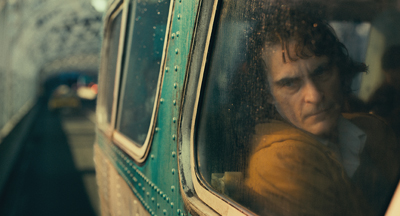 Phoenix concedes that, even during filming, "There were times when I found myself feeling for him, even feeling like I understood his motivation, and in the next moment I would be repulsed by the decisions he made. Playing this character was challenging for me as an actor, and I knew he would also challenge the audience and their preconceived ideas about the Joker, because in his fictional world, like in our real world, there are no easy answers."
Phoenix concedes that, even during filming, "There were times when I found myself feeling for him, even feeling like I understood his motivation, and in the next moment I would be repulsed by the decisions he made. Playing this character was challenging for me as an actor, and I knew he would also challenge the audience and their preconceived ideas about the Joker, because in his fictional world, like in our real world, there are no easy answers." "We often talk about the tip of the iceberg, but we rarely speak about what's underneath"about what gets you there," Phillips asserts. "Arthur is the guy you see on the street who you walk right past…or over. With this movie we're hoping to get a peek at what's below the surface."
It was those subjects, along with the filmmaker's passion for his medium, that evoked the notion of not just any Joker movie, but this Joker movie. "I was inspired by the character studies that I watched when I was younger. The look, the vibe, the tone of those films made sense for this story."
To Phillips, that meant the 1970s and `80s, the era of such great films as "Serpico," "Taxi Driver" and "Network." He says, "We included a few elements from the canon and set it in a broken-down Gotham City around 1981, because that harkens back to that era and would remove it from the comic book world we're so familiar with in film today.
Phillips not only cast Phoenix but wrote the part with him in mind. "Joaquin's previous work always stuck with me, but what I really like about him is his style and his unpredictability, which we felt would very much fit into this character," Phillips offers. "While other people are doing math, Joaquin is playing jazz. He's just one of the greatest, he's fearless; his work is brave and vulnerable, and I thought if we could get him, we could really do something special."
Though he'd resisted any sort of genre-inspired projects in the past, the actor was intrigued when he read the script. "I thought it was bold and complex and like nothing I'd ever read before. Todd has a unique way of looking at things that is really perfect, I think, for this movie," Phoenix observes. "When I work with a director, I want somebody who has a singular take on the material, and nobody could have made this movie but Todd."
Arthur's tale is at once rich and spare in details, alternately focused and skewed. Crafted with Silver over the course of, as Phillips recalls, "a year in a little office in New York," they began by determining a path to which such an ordinary man could become such an evil and notorious character. "In the version of the story we were telling, having a guy fall into a vat of acid didn't work, while I think it's interesting, so we tried running everything through a 'real world' lens," he says. "To make sense in the world of our movie, we thought, 'Well, why would he put this make-up on when he eventually becomes Joker? Where did he get this make-up and why does he have it? What if he's a clown?'
"Then, of course, we had to ask ourselves why he'd work as a clown," he continues, "which we determined was because his mother always told him he had to bring laughter and joy to the world. It all came together from there."
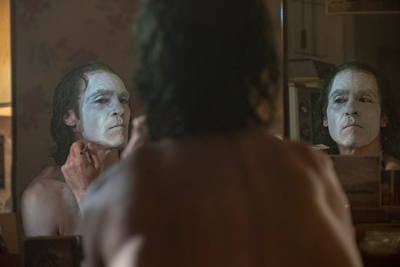 In addition to the visual expectations that come with the character, there's a distinct personality trait common across nearly 80 years of the comics and in every moving picture iteration, one which Phillips and Silver wanted to utilise in their storytelling: the classic unreliable narrator who can never fully be believed. "You have an intense amount of freedom with an unreliable narrator, and even more so when he's Joker," the director says of the famously deceptive reprobate, whose penchant for blending fact and fiction informs every frame of the film. "He even says in the comic book Batman: The Killing Joke, 'If I'm going to have a past, I prefer it to be multiple choice.' So, what really happened, and what you think he is by the end, just depends on the lens through which you watch the movie. You won't walk away having all the answers and that's what I think is intriguing about a character like this."
In addition to the visual expectations that come with the character, there's a distinct personality trait common across nearly 80 years of the comics and in every moving picture iteration, one which Phillips and Silver wanted to utilise in their storytelling: the classic unreliable narrator who can never fully be believed. "You have an intense amount of freedom with an unreliable narrator, and even more so when he's Joker," the director says of the famously deceptive reprobate, whose penchant for blending fact and fiction informs every frame of the film. "He even says in the comic book Batman: The Killing Joke, 'If I'm going to have a past, I prefer it to be multiple choice.' So, what really happened, and what you think he is by the end, just depends on the lens through which you watch the movie. You won't walk away having all the answers and that's what I think is intriguing about a character like this." To accomplish all that he intended with "Joker," Phillips and producing partner Bradley Cooper opted to conduct principal photography primarily in practical locations in and around the city that inspired Gotham itself: Phillips' native New York City as well as neighboring New Jersey. To that end, they enlisted producer Emma Tillinger Koskoff, an expert on filming in the region with connections to the city's strongest below-theline talent. "Emma is one of the great New York producers and we were lucky to get her," Phillips states. In addition to handily pulling together and managing all aspects of the physical production, Tillinger Koskoff says, "Todd had a unique and inspired vision of how he wanted the film to look and feel. My role was to help facilitate that vision and create a supportive atmosphere for him, so that he could focus on the actors and concentrate on what was happening in any given scene. Todd and I were fortunate to work with a fantastic crew"New York's very best. There was a level of trust and respect on our set that allowed him to work quickly and creatively. It was a privilege to watch Todd and Joaquin collaborate on this breathtaking film."
Phillips' creative team also included director of photography Lawrence Sher, this being their sixth film together; veteran production designer Mark Friedberg; costume designer Mark Bridges, who has worked several times with Phoenix; editor Jeff Groth, a regular collaborator; and composer Hildur Guðnadóttir, who began sending pieces of score to Phillips based on script pages alone, before a frame of the film was even shot. "It's always incredible to be making a movie when you have such brilliant creative partners," Phillips says, "and we really had the best there is on this film." Those words could easily be used to describe his onscreen talent as well, beginning with what might literally qualify as dream casting for any filmmaker: Robert De Niro. The legendary actor appears as latenight TV host Murray Franklin, the closest thing Arthur has to a hero and, though a stranger, someone he 6 Internal use only views as a kindred spirit in comedy. As many aspiring comics would know, being called over to the couch after your set on a show like Murray's is more than a game changer, it's life-altering, and Arthur's greatest wish...
"…She told me I had a purpose: to bring laughter and joy to the world."
"Arthur Fleck
Cast & Characters
In an early scene in "Joker," Arthur is meeting with a social worker, who asks him if it helps to have someone to talk to. Regardless of what his answer may be, it's clear from the expression on Arthur's face that she is not that someone. But it's equally unclear who"if anyone"is. "Arthur is always struggling with what it is he wants to say and how he wants to say it," says Phoenix. "His instincts just don't fit with the accepted standard of conversation or interaction…or anything, really."
Why he is the way he is will not always remain a mystery to Arthur, Phillips allows, but when we first meet him, he says, "Arthur is this guy who's very much like, 'I'm going to be the person you want me to be. I'm going to be proper, I'm going to take the bus and sit here quietly and not interact,' and so forth." But, like a dog that's been kicked repeatedly by its owner, sooner or later "this time" will be the last time. "There's always an inner part of him that has to try to be true to himself, to who he is becoming, and over the course of the story we see it coming out, little by little."
The truth of Arthur is complex. He attempts to do stand-up, his dream vocation and one for which he prepares by watching other comics, hoping to catch their tone and timing and adopt it for his own. Hoping that he, like they, will captivate an audience with witty observations and find an even larger form of acceptance in their applause. "Unfortunately, how he sees the world and, frankly, what he thinks is funny don't really work," Phoenix describes. "He doesn't understand their kind of humor and he isn't able to mimic it, either."
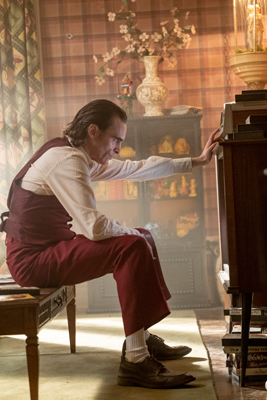 Servicing the self-fulfilling prophecy of his mother's "Happy" appellation for him and long before Arthur musters the courage to try his hand on the comedy club stage, we find him at his day job as a clownfor-hire via a service called Ha-Ha's. The job takes him to various parts of the city, but no matter where he goes, the walk home inevitably entails a haul up a lengthy flight of outdoor stairs.
Servicing the self-fulfilling prophecy of his mother's "Happy" appellation for him and long before Arthur musters the courage to try his hand on the comedy club stage, we find him at his day job as a clownfor-hire via a service called Ha-Ha's. The job takes him to various parts of the city, but no matter where he goes, the walk home inevitably entails a haul up a lengthy flight of outdoor stairs.
Steps, both physical and metaphorical, factor into Arthur's world with regularity, from the ones he climbs to the steps he takes to apply his Happy make-up. Both are just indicators of the many more steps he will take as he metamorphoses into his true self over the course of the film.
Much of that character building came about through Phoenix's preparations for the role, taking a cerebral preparation and turning it corporal. In the film, on the advice of his social worker, Arthur keeps a journal, which also contains his drawings, prose and imaginings. Throughout pre-production, Phoenix himself made several entries. The actor states, "I was writing in Arthur's journal when Todd sent me a note about the set of steps in the story. That inspired me to write 'step after step after step,' over and over and line by line across the pages, and then it became something we'd text to each other."
In the beginning of the film, we see the wilted way Arthur carries himself as he ascends the stairs, building on another idea Phillips implanted in Phoenix, that Arthur walks with "heavy shoes," carrying the weight of the world with him. When he later descends them, however, we see not only a very different Arthur, but a wholly different carriage.
No matter the preparation, Phillips observes, "All the preparation disappears into the performance. Joaquin is so methodical about it that there's not one moment where you see him switch from Arthur to Joker, it's all done with a very measured pace."
Another part of the actor's dedication to Arthur's presentation was to drop 52 pounds, by consuming little more than an apple a day. Phillips confesses it was his idea, stating, "I wanted the character to look hungry and unhealthy, like a malnourished wolf."
Phoenix and Phillips developed a close relationship during filming as they worked to discover and define the finer points of Arthur's dual nature. With careful consideration over the course of the story and a traditionally unreliable narrator like Joker setting the scene to emerge from within the chrysalis of this socially awkward and increasingly desperate man, they left the very truth of Arthur Fleck's story open to interpretation, like Arthur's own experience.
"There were times when I thought Arthur would enjoy altering his story because of the effect it would have on how someone might feel about him, and there were other times where I thought he'd alter it because it's what he really believes," the actor offers. "Usually with characters that is frustrating, not understanding their motives; but with this character it became liberating, realising it could go in any direction. Working with Todd on a scene, if we didn't find a surprising way of exploring it in the moment, we felt like we weren't doing it right."
Those discussions continued throughout production and long after each day's filming wrapped. "After we finished shooting, we would call or text for hours and talk about the next day's scenes, and on weekends we would meet and go over scenes we were shooting that week," Phoenix remembers. "I felt like we were so unified throughout the process; if one of us ever got to the point where we weren't feeling inspired, we trusted the other one to inspire them, and that was really satisfying."
Arthur lives with his frail mother, Penny Fleck, and devotes himself to caring for her. Penny resides in their tiny apartment, but in truth she lives in her own world, despite his company. Her focus is split between the TV and all that is wrong with Gotham, writing letters to Thomas Wayne. Having worked for him 30 years ago, she's certain the wealthy businessman considering a run for mayor would help her out if he only knew of her current circumstances.
Veteran actress Frances Conroy, who plays the rather delicate woman, admired the dedicated Phoenix, noting, "He is quiet, he is at one with his role and with the other actor in the scene." It's almost as if, she adds, "I know Arthur, not Joaquin. He is the character only, he leaves himself behind and lives only in the reality of the scene."
Robert De Niro plays the role of Franklin, an amalgam of real-life past hosts from Joe Franklin to Johnny Carson. Phoenix recalls their first day together on the set, during which he and De Niro had a lengthy scene to film. "You have this fantasy that you're going to ask him all these questions because, of course, he's Robert De Niro. You're so excited when that opportunity comes your way, but then you realise you have a nine-page scene and there's no time and no chance you're going to be able to ask him all the things you want to."
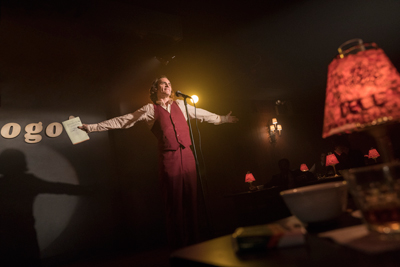 Phillips took a very different approach when first meeting the icon. "I had gone to his office before we shot and I said to him very clearly, 'Listen. I've got to spend ten minutes just talking about all these questions I have for you, and then I swear I will be a professional.' And we ended up going for at least 20 minutes, and it was great."
Phillips took a very different approach when first meeting the icon. "I had gone to his office before we shot and I said to him very clearly, 'Listen. I've got to spend ten minutes just talking about all these questions I have for you, and then I swear I will be a professional.' And we ended up going for at least 20 minutes, and it was great." In his quest for an emotional connection, Arthur also dreams of his neighbor Sophie Dumond. He has a crush on her, but it's the kind of puppy love that has him watching for a glimpse of her.
Zazie Beetz, who plays the single mom of a five-year-old girl, says, "Sophie and her daughter live down the hall from the Flecks, and she encounters Arthur in the elevator, places like that, as you would. She's raising her child on her own and probably has a tough time. She can see, though, that he has difficulty interacting with people and seems somewhat insecure, so she tolerates him and is nice, and she smiles at Arthur like you do with any neighbor."
Beetz thoroughly enjoyed working with Phoenix, stating, "I've been a really huge fan of Joaquin's work for a long time and I think he's one of the best actors of this generation." With equal praise for Phillips, she adds, "I'd never really had an experience like this one before. It was so incredibly collaborative."
Brett Cullen also stars as mayoral candidate Thomas Wayne, a lone father figure Arthur attempts to connect with only to be rejected at every turn. And Douglas Hodge is Alfred Pennyworth, Wayne's hired man who protects the manor interests great and small from the likes of someone like Arthur.
Rounding out the impressive cast are Shea Whigam and Bill Camp as GCPD detectives Burke and Garrity; Glenn Fleshler as Randall and Leigh Gill as Gary, Arthur's fellow clowns at Ha-Ha's, where Josh Pais plays his boss, Hoyt Vaughn; Brian Tyree Henry as Arkham Clerk Carl; and Marc Maron as The Murray Franklin Show producer, Gene Ufland. Real-life comics Gary Gulman and Sam Morril appear as stand-ups in scenes at a comedy club.
"Is it just me, or is it getting crazier out there?"
"Arthur Fleck
Production Design / Locations / Camera
In order to enhance Arthur's internal struggles with his own sense of realism, Phillips sought to counter it by grounding the film itself in as authentic an aesthetic as possible. "As a filmmaker, there are a lot of tools you have to paint with, and locations and set design are big ones in this film. His environment represents quite a lot in Arthur's life, so we wanted to use that to the fullest effect."
He worked closely with production designer Mark Friedberg who, like Phillips, grew up in New York City and was very familiar with the palette the director sought. "Mark combed through old photos of New York to find the right level of graffiti, the right amount of trash and the picture cars that we'd want. His attention to detail was amazing," he remarks.
"What I found poignant about the Gotham Todd and Scott created is that it's a world I understand, a world that's hard, a world that's hard on the people for whom life is hardest," Friedberg says. "The dysfunction, the disconnection from the powers that be…that's the New York City of my youth. It was dirty, every city agency was on strike at some point and the ones that weren't were corrupt. That's what I thought made this such a striking piece when I first read it and that's where our conversation started about this world of "Joker""a Gotham that is not New York but is its own dark, gritty, tough urban city with roots in our collective past." 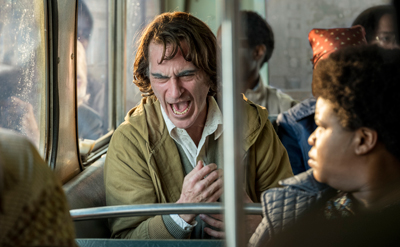 Phillips and his creative team talked extensively about what Gotham City meant to them, whether from the lore in the comics or other visual interpretations. To aid in their discussions and later in the physical production in terms of where Arthur's daily travels took him and how he got there, Friedberg actually drew up a Gotham City transit map much like those posted in New York City subway terminals and, in fact, the designer's map appeared in just such a manner during filming.
Phillips and his creative team talked extensively about what Gotham City meant to them, whether from the lore in the comics or other visual interpretations. To aid in their discussions and later in the physical production in terms of where Arthur's daily travels took him and how he got there, Friedberg actually drew up a Gotham City transit map much like those posted in New York City subway terminals and, in fact, the designer's map appeared in just such a manner during filming.
Though they steered clear of incorporating too many elements from the canon, those that they did include were altered slightly to reflect the city they were devising. "Everything is a riff on something," Friedberg smiles.
Phillips elaborates, "Arkham Asylum in our movie is called Arkham State Hospital, because that seemed to us what they would really call it."
Harlem's Metropolitan Hospital stood in for Arkham's interiors and for scenes inside a children's hospital ward, while the exteriors were shot in Sunset Park, Brooklyn, at the Brooklyn Army Terminal, a 100- year-old example of industrial style architecture.
Identifying all the practical locations required for a film featuring a 1970s/80s Gotham City was a challenge, Friedberg says, because "the physical world we were trying to depict is not that available as we've slowly been turning our cities into glass skyscrapers and malls. To find the version of the city we needed, we actually ended up going to Newark"where we built Gotham Square"and Jersey City, New Jersey, and to the boroughs."
To help dress Gotham Square in Newark, a young local artist, Malcolm A. Rolling, was hired to paint murals on the sides of buildings along the streets where filmmakers were shooting exteriors. The murals reflected the themes represented in the film, and some were nearly a city block long.
The production also shot sequences in Brooklyn at the fabled Kings Theater. The movie palace originally opened in 1929 but had been recently renovated, and in the film stands in for Wayne Hall. The 11 Internal use only Highbridge and Kingsbridge working-class districts of the Bronx served as the neighborhood where Arthur lives in a tenement with his mother, Penny, and the neighbor he admires, Sophie.
A nearby Bronx locale that recurs several times in the film is a long set of steps where we find Arthur making the climb home again and again, symbolic of the drudgery he's returning home to. "Todd's idea was to set Arthur in the hilly South Bronx, one where he's trudging up public stairways and through alleys, in nongrid-like streets, which confuses his world in a way that really works for this story," Friedberg states. "People don't think of hills when they think of New York, they think flat, so that gave us an unexpected topography and a specific visual style." That visual style was defined in concert with director of photography Lawrence Sher. "Larry is probably my most trusted creative partner, we've traveled the world together shooting movies," the director says.
Sher relates, "Todd has skills that are really unique in a lot of ways. He cares about the writing, the performances, the visuals and the editing immeasurably, and is able to blend all four of those elements together seamlessly in a way that he's not putting emphasis on one over the other. A lot of times you'll shoot a lot of coverage and wide shots and, in every movie that we've done together, he always allows the performance to shine first and foremost, but also weaves in the coverage in a way that always gives the movie scope, allowing it to be really cinematic. Todd and I challenge each other every single day and it's a really satisfying experience working with him. It's the right kind of push and pull, the kind of pressure that creates diamonds. We never want to feel like we left something on the table after a day of shooting."
That close working relationship has naturally created the kind of shorthand between them that a true partnership provides. "Because this is our sixth movie together, the discussions we have are much more about ideas within individual scenes, which then build and create the bigger picture," says Sher. "On this film, at one point I remember Todd talking to me about the idea of the shadow self, the shadow representing the other side of ourselves, and the transformation of Arthur into Joker. Those two terms"transformation and shadow"really informed me and gave me an early idea of what themes he was going to explore over the course of the movie, so I could determine how to best express that visually through the imagery.
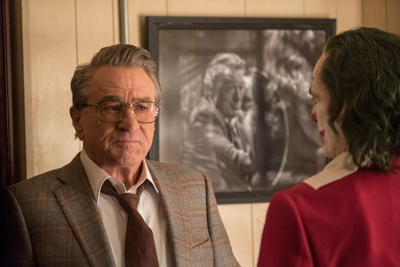 "Much of our approach," he continues, "was to figure out how you take what is basically a character study and tell it visually in a way that doesn't have to depend on dialogue. A way that you could even watch the movie silently and get the same emotional impact, because Joaquin's performance is so measured, and he says so much without saying a word."
"Much of our approach," he continues, "was to figure out how you take what is basically a character study and tell it visually in a way that doesn't have to depend on dialogue. A way that you could even watch the movie silently and get the same emotional impact, because Joaquin's performance is so measured, and he says so much without saying a word."
Sher says that the choice to use the 65 Alexa was key in that regard. "A large format camera like that gives you a lot of separation through the shallow depth of field. That allowed us to isolate Arthur in his Internal use only world, making him the sole character within it and enhancing the idea that he's an outcast, and sometimes sees himself as not even existing. The camera helped us tell that side of his story, whether in the intimacy of his apartment or in larger scenes, because we could separate him out from his background."
Many of those larger scenes take place outside. Sher offers, "Todd, Mark and I all grew up in and around Manhattan and were there in the time this movie takes place, so we remember it vividly and were able to draw on that every day. But where do you go in this city that they haven't come in and put up high rises? From frame one, we wanted people to be instantly transported to our version of Gotham circa 1981, and never think, 'Oh, he's in Newark.' Mark found locations that were nearly untouched and still represented an earlier era. He of course added a lot of trash and changed signage and so on, to give it a sense of place and time that's not just period, but also tonal. A much grimier, trash-infested city of Gotham at a breaking point."
"From wide shots of Gotham Square to a guy sitting in his seat on a bus or walking along Jerome Avenue under the elevated tracks to the tininess of his apartment, Larry was really interested in contrasting this small person in a big world, and then this small world with that person in it," Friedberg notes. "For me, that meant going from general compositions to specific textures, from an anonymous little flea moving about the big streets of our city to the minute detail of a burning cigarette. For example, if you walk into old tenement buildings in the Bronx, you will see extreme texture, you will smell extreme texture, and photographically that's beautiful to me. Todd was open to me pushing that extreme contrast with texture in a way that makes it feel very real."
One such example is a public restroom Arthur flees to at a pivotal moment in the story, which turned out to be a pivotal moment for Sher and his "A" camera /Steadicam operator Geoff Haley as well. Sher explains, "Philosophically as a DP, and paramount to Todd in the way we photograph movies, is that we light the environment and let the actors exist within the whole of that environment, which allows them full freedom of motion. In this movie more than ever before, my team would walk into a scene and not know anything of what Joaquin was going to do. Todd and Joaquin had discussed it, but my operator and I would set it up in a way that would just let him do whatever he wanted, just let it happen. That started with the bathroom scene"and Todd and I love grimy bathrooms, you'll find bathroom and elevator scenes in all six films we've done together. We set the mixed lights, uncorrected fluorescents, had no rehearsal for camera, and when we rolled, we just stayed with Joaquin.
"Joaquin is extremely present and immensely connected in the moment," he continues, "so, as the DP or the operator, you want to raise yourself to that level of being present and seeing where it goes. My 13 Internal use only operator and I were each on a camera and we let things unfold, dancing around JP as he discovered the scene in real time. That approach then became something we did in a lot of scenes, like the one in his apartment when Arthur climbs into the refrigerator. That was completely unplanned and of the moment. It was a thrilling experience to do a movie that way"precision, in terms of shots we knew we wanted to get, and complete improvisation in terms of performance."
Adhering to their rule of authenticity, Friedberg and Sher worked together to build and light another key set in the film, the "Live with Murray Franklin" show. "Mark's designs and everything we used to light the set were authentic to the time, none of the modern technology of lights was used," Sher states. "I'm a cinema snob and I've spent my life trying to avoid doing television, but I've ended up several times designing television shows that exist in the movies I'm making," Friedberg laughs. "One of the more significant sets in this movie is for the Murray Franklin show. We didn't copy Carson, per se, but we went in with that recipe: a desk, a chair, another chair and a couch, a guy who announces and sits down, seats for a live audience, a band…all those things and a control room, and dressing rooms, too. What was interesting for us was to build this 'old' style set that turned out to be the first set ever on a brand-new stage at Steiner Studios."
Friedberg's team sourced authentic period television cameras for those scenes as well, from the Museum of Broadcast Technology in Rhode Island. Old-fashioned functional monitors were installed onto the cameras so that there were images on the lenses as they simulated filming.
Period subway cars circa 1970-80 were also used during production, obtained from the New York City Transit Museum and operated by certified Metropolitan Transit Authority (MTA) personnel. Filming took place on lines in Brooklyn and the Bronx, deep inside tunnels, on elevated tracks and on platforms, many of which were open to the public, so the actors were performing as real riders disembarked and boarded the cars.
Scenes where we find Arthur first in the audience, and then performing his first stand-up gig, were shot at the famed comedy club Dangerfield's on Manhattan's Upper East Side. Named for renowned comic Rodney Dangerfield, it opened in 1969 and is the oldest functioning venue of its kind in the city.
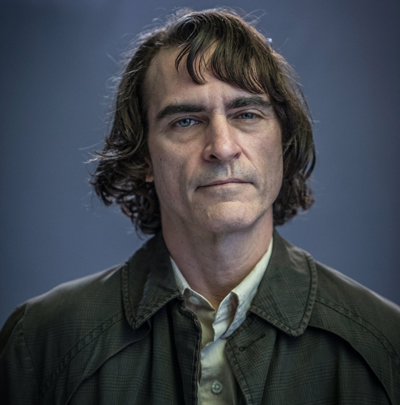 Becoming Joker - Costume Design
Becoming Joker - Costume Design
To create Arthur's"and, via stages, Joker's"look, Phillips sought out costume designer Mark Bridges, who had designed for Phoenix in both "The Master" and "Inherent Vice." Bridges notes, "Those films are also set in periods of transition, one in the 1950s and the other in the 1970s."
As in the former, Phoenix's physique became quite slim by the time filming began. "I honestly don't know how he does it," Bridges posits of Phoenix's discipline, "but we started fittings six months before filming, so it became part of my collaboration with him, too"not just tailoring things to fit, but are we hiding his physique in this scene, are we playing it up in that one?"
Phillips had never worked with Bridges before, but greatly admired his designs. "Mark is incredible," the director comments. "Just going to Robert De Niro's suit fittings with him was an experience. And because he had worked with Joaquin a few times before, they already had a great rapport."
Bridges was flattered when Phillips reached out. "Todd sent a lovely note that said that he had this project coming up and would I consider working on it. Certainly to get a note like that from someone of Todd's caliber… And of course working with an old friend like Joaquin is truly a joy for me. We have a wonderful back and forth and I trust him. We talk and he's quite open to my suggestions as to how best represent on the outside this person he's working on on the inside. So, all the pieces fell into place based on Todd's personal request."
For the period in which "Joker" takes place, Bridges observes, "If you're true to, say, 1981, there was a certain range of colors and color combinations available in stores. We used a lot of blue, brown, maroon, mauve, gray, navy, khaki… We moved away from the burnt oranges and greens of the `70s, though I still threw in a few for the story's sake. But just by adhering to that palette, it automatically feels like some other time because it's not what they're selling in the stores right now."
Insofar as Arthur's fashion sense goes, Bridges says, "He's very much a John Q. Public, so to speak; not much style that isn't very practical. He dresses for comfort and has had his clothes for a while, and there's a vague childlike aspect to it as well as an old man look to it. With Joaquin, I don't ever want to give too much away with the choices I make because his performance is so strong."
In the opening frames of the film, however, we see Arthur at work, which involves an actual costume that would be of Arthur's own design: party clown. "Knowing that some of the character's movements in the film were inspired by some of Charlie Chaplin's moves, I worked a little bit with that silhouette, as well as the knowledge that it would be something Arthur's put together in a very makeshift way." Bridges does acknowledge, however, "One personal conceit of mine is the little derby he wears, because I've always loved that on clowns."
And, of course, Arthur wears the traditional big clown shoes as well, in which Phoenix was required to run several times"no easy feat.
When it came down to the actual Joker costume for the film, Bridges happily reports that its design was, in part, written into the script as "a rust suit Arthur has had for many years." Still, he confesses, "You have a million thoughts running through your mind and there's a little bit of external pressure to serve the fans as well as the piece. But ultimately my work comes down to telling this particular story, where the outfit has to be something very organic to the character: pieces we've seen Arthur wear before, now reassembled to become what Joker wears."
Working backwards, Bridges was able to determine when and how much of the building blocks to the final look would appear throughout the story. "I started from the beginning and then took it on a journey" this piece in the comedy club, how it gets recombined with different items at different beats"to get to the final result. When Joaquin and I had our final fitting for the full suit, it was all put together with the right shirt, the right waistcoat… It was dead-on `70s with a slightly longer line in the jacket, and he took on a strange, slinky confidence that he doesn't have as Arthur, but which was just right for Joker. To me, that was really satisfying."
Phoenix adds, "As Joker, he walks tall. He's confident. Prior to that it's like he was a shell of himself."
Throughout the film, Arthur dons a clown face of varying degrees for various performances. His ultimate Joker look was designed by Phillips and Phoenix as an exaggerated version of Arthur's regular maquillage and executed to perfection by make-up department head Nicki Lederman and her team, utilizing the basic red and green of Arthur's clown character. Lederman herself created a unique shade for Arthur's tears from various pigments she had on hand, dubbing it antique blue.
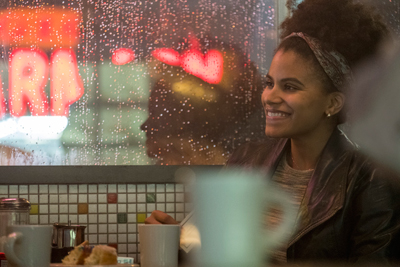 "I used to think that my life was a tragedy, but now I realise it's a comedy."
"I used to think that my life was a tragedy, but now I realise it's a comedy."
"Joker
To interpret the many themes explored throughout the film, Phillips very early on turned to composer Hildur Guðnadóttir. "Hildur was writing music as far back as pre-production," Phillips recalls. "I was sending her script pages and she was writing music before we even shot, and what she did for the film is so unique."
Guðnadóttir says, "Todd asked me to write some music based on my feelings from reading the script, which I was inspired to do because it truly resonated with me." She sent him a sample and recalls, "He thought that I had really captured the atmosphere of the movie."
What struck the composer the most, she says, "was Arthur, this character with a kind of multidimensional simplicity, so openhearted and childlike, who is just trying so hard to fit in. But his circumstances and how people react to him don't really allow for that to happen. Musically, that translated to melodies that are very simple and monotonic, because that's kind of the way he is seeing things. Then I tried to expand within that simplicity the orchestration around it not with chords or any complicated music, but with texture that I felt resonated with the melancholia of his character."
Her composition features the cello as the centerpiece of the score, leading the very string-based melodies. Guðnadóttir reveals, "There is often a whole symphony orchestra of 90 musicians playing the same thing, but it's hidden behind the cello. I felt that went well with the character, he is seen in this certain way and there are many layers of complication behind him, but he doesn't see it. I thought orchestrating it that way, so that instruments are not always audible, you will think you're just listening to one cello but, like Arthur, there are layers behind it."
Guðnadóttir began work so early that Phillips was able to introduce it during production and brought a piece to Phoenix just a few weeks into filming as a means of inspiring his work in a pivotal scene, one in which the audience will see the first hint of things to come. "Joaquin and I were on the set and at a standstill," the director relates. "We hadn't really figured out the scene, but then I remembered I'd just gotten this great piece of music from Hildur that I'd been listening to the night before. I played it for him, he loved it, and he just started doing this slow dance to it, and out of nowhere this gracefulness comes out of Arthur, the emergence of his shadow. We started filming him, and that became the beginning of his transformation."
Phoenix attests, "Todd started playing this cello music, and it was really effective. I said, 'So, maybe there's a movement,' and he said, 'Well, I would start on your foot"that's your move.' That's all he said and all we had. The preparation was in studying movement and dance during rehearsals, but what came out of that piece of score was a turning point for the character, and for me and Todd working together…and understanding Arthur."
Joker
Release Date: October 3rd, 2019
MORE



